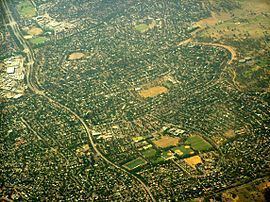Postcode(s) 2614 Area 160 ha Postal code 2614 Federal division Division of Fenner | Gazetted 22 August 1968 Population 2,608 (2011 census) | |
 | ||
Weetangera is a suburb in the Belconnen district of Canberra, located within the Australian Capital Territory, Australia. The suburb covers an area of approximately 158 hectares (390 acres). Located approximately 10 kilometres (6.2 mi) north-west of the city, Weetangera is bounded by Springvale Drive to the south and west, Coulter Drive to the east and Belconnen Way to the north. The Pinnacle Nature Reserve, a Canberra Nature Park is adjacent to the south of the suburb, across Springvale Drive.
Contents
- Map of Weetangera ACT 2614 Australia
- Name
- Political representation
- Demographics
- Suburb amenities
- Educational institutions
- Historic Public School
- People honoured in the streets of Weetangera
- Geology
- References
Map of Weetangera ACT 2614, Australia
Europeans first settled the area in the 1800s, and it was named Weetangera after the property "Spring Vale", which in turn had been given a name of Aboriginal origin (it is also called Weetangerra and Weetangara in early documents). A school was first built in the area in 1875.
The modern suburb of Weetangera was officially gazetted by the ACT Government in 1968, with a street theme: 'Pioneers of the Australian Capital Territory'. After the gazetting, the first modern settlers moved into the suburb in 1970 and the first students moved into the Weetangera Primary School, located about a kilometre from the old Weetangera Primary School, in 1973. Today, the suburb is home to over 2500 people.
Name
Weetangera is named after the property "Spring Vale", which in turn had been given a name of Aboriginal origin, due to a spring near the site of the original Public School called "Wittanjirra" in the local Aboriginal dialect, meaning "to suck, to drink greedily". Samuel Shumack lived at "Spring Vale" between 1866 and 1915. Shumack and his father had taken up the land for farming when Samuel was eight years old. Samuel Shumack lived on the property with his family until it was claimed as land for the nation's capital in 1915.
Weetangera was also the name for the Weetangera parish, which included the land from Ginninderra Creek to the Molonglo River. The Southwell family were significant to this property, and various members of the family are buried in the Weetangera Cemetery and former Methodist Church now sited to the west of the adjoining suburb, Hawker.
Political representation
For the purposes of Australian federal elections for the House of Representatives, Weetangera is in the Division of Fenner.
For the purposes of Australian Capital Territory elections for the ACT Legislative Assembly, Weetangera is in the Ginninderra electorate.
Demographics
People who live in Weetangera are called Weetangerans. On Census night 2011, Weetangera had a population of 2,608 people. The census shows that Weetangera residents have a median age of 40 which is slightly older compared to an ACT median of 34 and an Australian median of 37. The median weekly household income was A$2,446, $526 more than the ACT median and nearly double the median Australian household income of $1,234.
Weetangera's population is predominantly Australian-born; 73.5 per cent on census night 2011. The second most common birthplace was England at 5.1 per cent. The most common religion is 'no religion', with nearly a third of the population reporting they were not religious.
Suburb amenities
Weetangera has a small shopping centre containing a bakery, beauty salon, jewellery shop and a publishing company.
The suburb is also home to the Weetangera Neighbourhood Oval. The ACT Government announced restoration plans for the oval in June 2012, committing $4 million to three ovals, including the Weetangera oval, over a three-year period. The money is for the installation of irrigation systems, synthetic cricket wickets and practice nets, floodlights and a small pavilion and toilet block.
Educational institutions
Both Weetangera Primary School (1973–present) and Weetangera Preschool.
Historic Public School
The first Public School (pre-High School) was sited on land of the original farming property, and opened on 27 April 1875, with 27 students. The first teacher was Mr Ewan Cameron, a member of the Weetangera community and a parent of a student.
The site is between (beside) the present Belconnen Way (north) and Smith and Kinleyside Streets (south). It now a park, with children's play area, with several lines of pine trees that were planted by students of the original school in about 1919 and 1928/9 (Arbor Day).
People honoured in the streets of Weetangera
The street names in Weetangera are predominantly named for ACT pioneers:
Geology
Silurian age green grey rhyodacite of the Walker Volcanics underlie the whole suburb.
